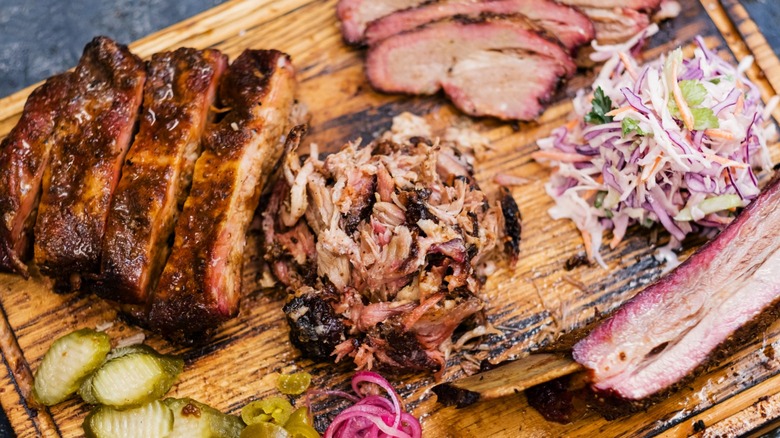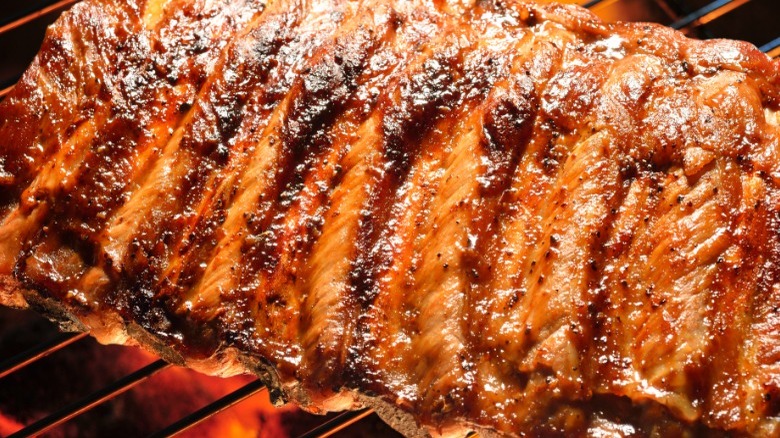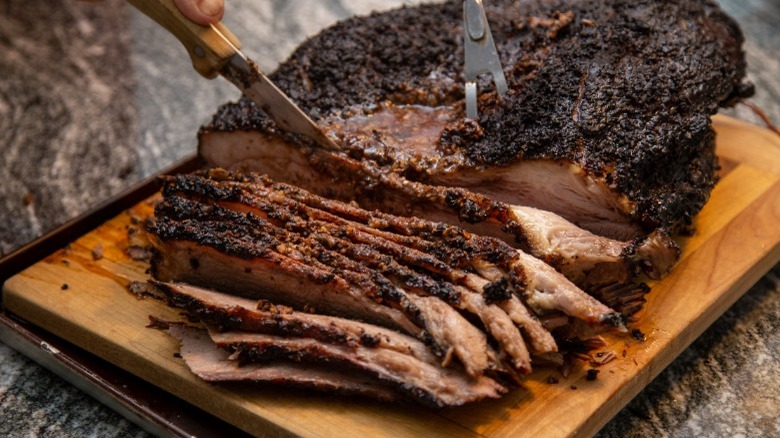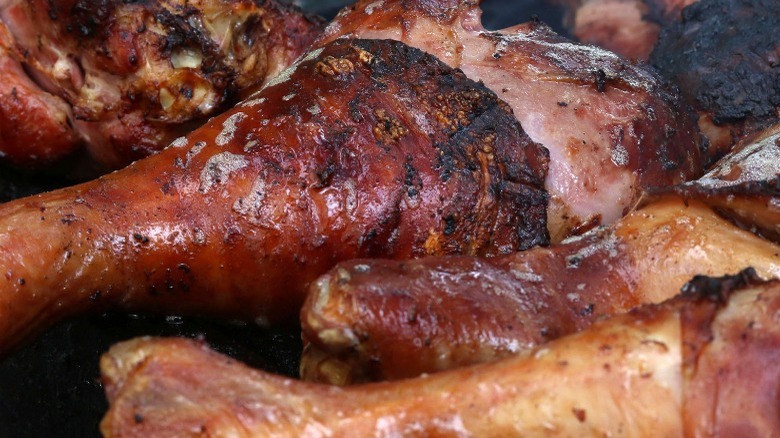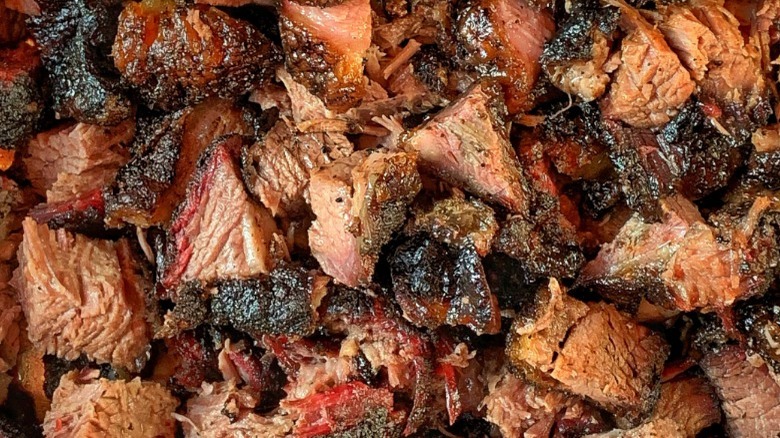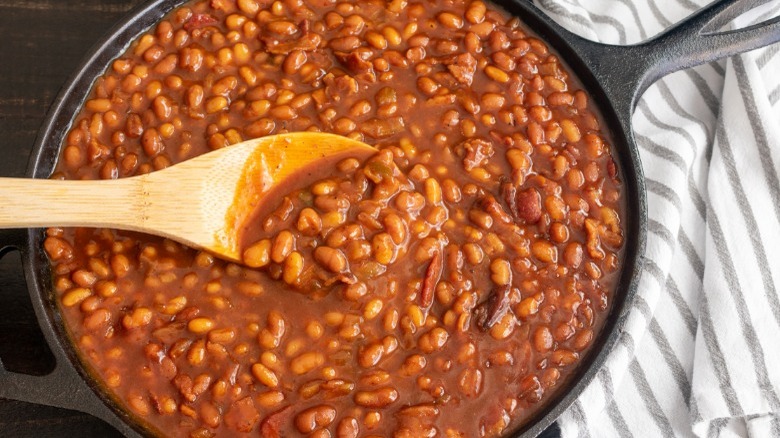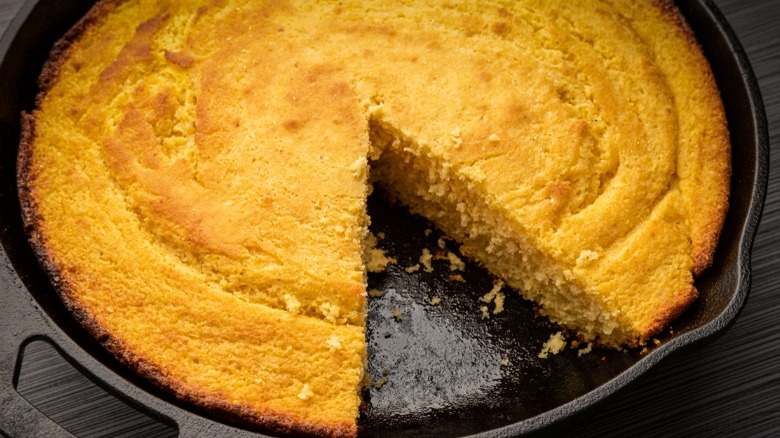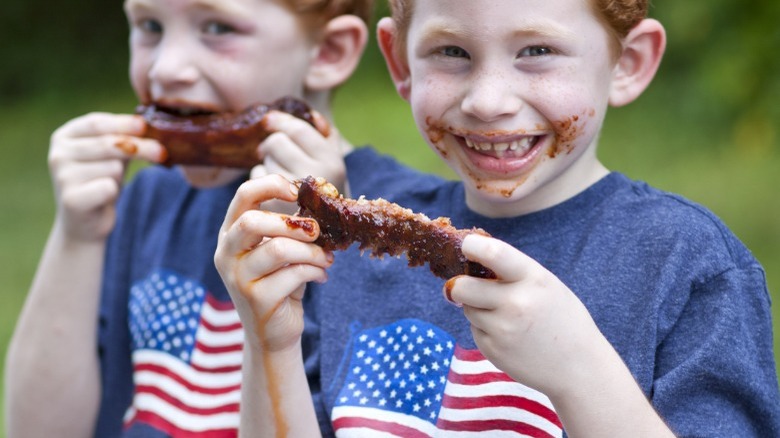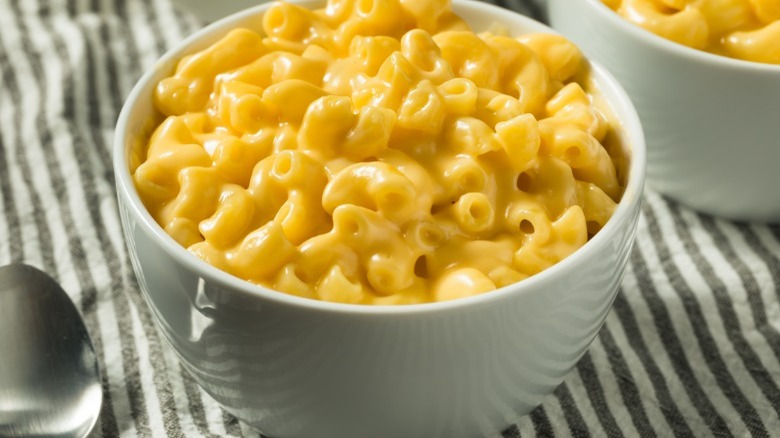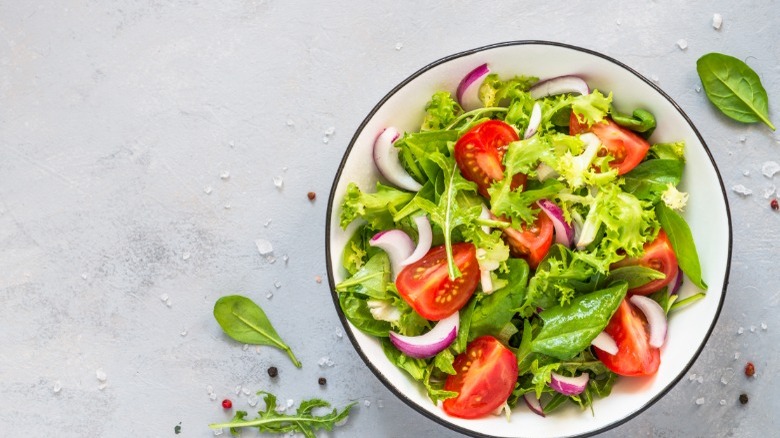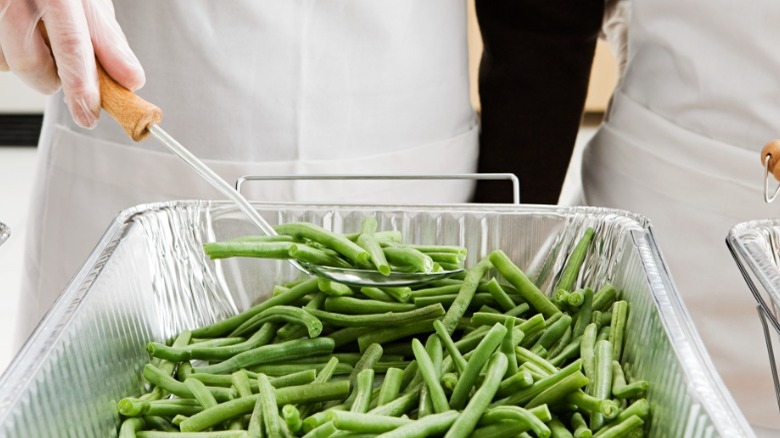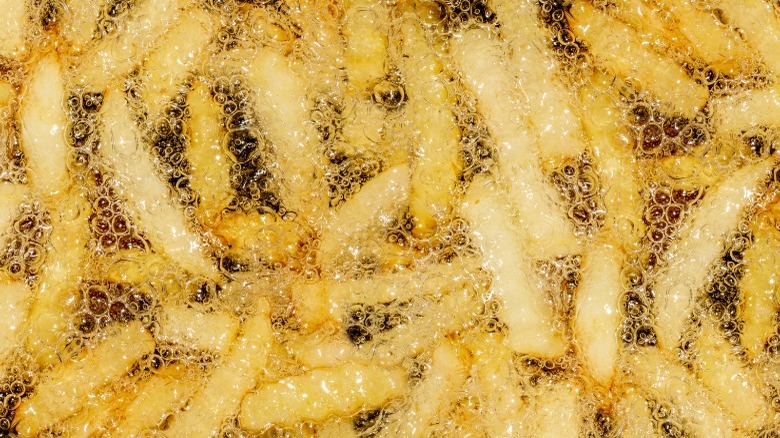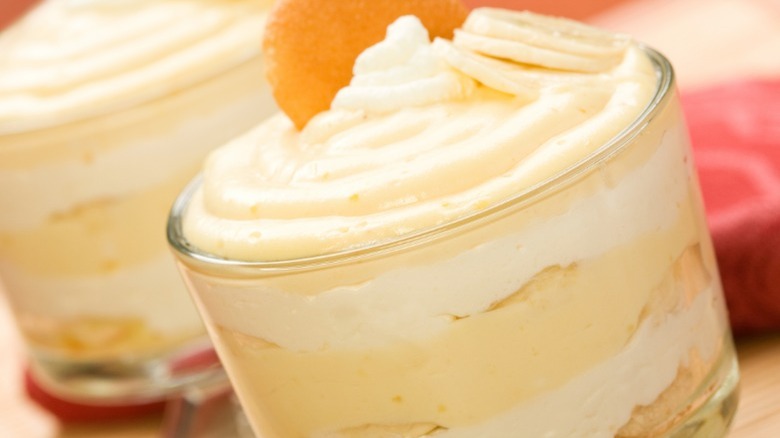7 Foods You Should Order At A Barbecue Restaurant, And 5 Foods You Shouldn't
The very best barbecue restaurants take their food seriously: They have stellar reputations and fiercely loyal customers. According to Dyer's Bar-B-Que, the size of the joint doesn't matter; it can be a streetside, no-frills barbecue joint with a line out the door, a posh urban restaurant with a full bar, or something in between. The most obvious sign of a great barbecue restaurant is the aroma of smoking meat that makes your mouth water.
If you can't detect the smell, the food may not have been cooked in a true barbecue pit or (heaven forbid) was been cooked elsewhere and brought in. Other things to look for include plenty of extra napkins (or a roll of paper towels) on the tables, meats that are not served drowned in sauce, and a picture of a cartoon pig wearing an apron and chef's hat. We're not joking about that last one.
That being said, there is more than one style of barbecue. WebstaurantStore describes the four big regional ones: Kansas City, Memphis, Carolina, and Texas. The differences between these lie in the different types of meat, rubs, sauces, cooking wood, and sides.
People have their favorites and aren't afraid to share their opinions, but we think that they're all great in their own ways. The caveat is to know what to order when you're in a barbecue restaurant and what to avoid. You can't go wrong with certain things, but others are not as dependable.
Do order: Pork ribs
Spare ribs and baby backs rule the roost at many barbecue restaurants. When pork ribs are featured on the menu, you have to order a half or full rack. However, as Seven Sons explains, spare ribs and baby back ribs are different cuts of pork.
Spare ribs are larger and come from the bottom of the pig, while baby backs are from the loin and back. And since baby backs have 11 to 13 small ribs, they are not as likely to be shared as a full rack of spare ribs. The latter are also referred to as Kansas City or St. Louis cuts.
Memphis Wood Fire Grills has many good things to say about pork ribs, enthusing about the high-fat content that contributes to the juiciness and flavor. But even though spare ribs have longer bones, there's less meat to gnaw on. On the other hand, baby backs have a lower fat content and might not have as much flavor. That's why they are often served with more sauce than their bigger cousins.
There are other kinds of pork ribs, like country-style ribs. BarbecueFAQ.com explains that these are sourced from the pork loin, which is closer to the shoulder. The baby backs come from the bottom part of that loin. Carnivore Style claims that country-style pork ribs are lean and meaty. They're served bone-in or boneless and are also referred to as Western-style ribs.
Do order: Brisket
A good cut of brisket improves with age: It will melt in your mouth after being smoked for hours on low heat in a barbecue pit. Traeger calls it one of the best barbecue meats and explains that it comes from the lower chest or breast of a cow.
Brisket has a hearty, savory taste that can be compared to a ribeye steak, and it is a tougher cut of meat. It's also the main ingredient in corned beef brisket that you won't see that at barbecue joints.
Barbecue masters might trim some of the fat from a whole brisket, leaving about one-fourth inch on the outside. These chefs generally don't add a lot of seasoning since the meat is so full of flavor, and the barbecue does most of the work. A massive 20-pound brisket might take 20 hours to cook and will be tender enough to cut with a fork after it's taken out.
It can be sliced, chunked, or shredded and served in sandwiches. Forbes Hever & Wallace, Inc. explains that after brisket is cooked, it gets held in hot holding cabinets. The meat tenderizes even more in the cabinets, after which it's just waiting to be plated and served to hungry (and lucky) customers.
Do order: Smoked turkey
Have you ever tried a smoked turkey leg at Disney? There's a reason why these things are so popular. Smoking turkey elevates the bird to new heights with its unbeatable, smoky flavor. Barbecue restaurants might sell eat-in smoked turkey parts, breasts, or whole turkeys, skin included.
An ABC7 Chicago video shows Bonni Cameron from County barbecue preparing a whole turkey for the smoker. She claims that the meat comes out juicy, tender, and browned on the outside. Turkey is a good option if you are trying to eat healthier, too.
According to the University of Illinois Extension, a 3.5-ounce portion of dark, skin-on turkey meat has 13 grams of fat, while white, skin-on turkey has 8 grams of fat. Much of the fat content comes from the skin, of course, but why order anything with the skin at a barbecue restaurant if you're going to take it off? Come on, now.
But how does turkey compare to spare ribs and brisket? According to Carb Manager, a three-ounce serving of spare ribs has 25.8 grams of fat, and a brisket of the same size is not far behind at 21.8 grams. Brisket is an incredible dish that you should definitely order at barbecue restaurants.
Do order: Burnt ends
These blackened, buttery-soft brisket chunks sell like hotcakes at barbecue restaurants because they don't have bones and are easy to eat. But that's not the only reason. WebstaurantStore raves about burnt ends, describing them as soft yet chewy, with a sweet texture. They can be made from fatty pork belly or brisket.
Burnt ends are prepared with spicy dry rubs, and barbecue pit smoke caramelizes the meat and creates the dark, crispy outsides known as bark. As you chew through the bark, the juicy meat inside will make your tastebuds sing with joy.
Burnt ends can be served with or without sauce, and we recommended a dry taste before dunking them in anything. Another great thing about these chunky morsels is that they're cut into pieces, so you can use a knife and fork to eat them. Hey, we have nothing against eating with your hands at a barbecue joint, but it's nice not to use up half a roll of paper towels. Another plus: Burnt ends make for faster eating.
You are less likely to see rib tips on a barbecue restaurant menu; these are also delicious, but not the same thing as burnt ends. Foodland explains that rib tips come from the bottom portion of spare ribs that are sometimes cut off. And they contain cartilage rather than bone. If you have a choice between burnt ends and rib tips, we say go for the first choice with gusto.
Do order: Baked beans
When you're at home, you might open up a can of baked beans to have with hot dogs, but authentic barbecue restaurants make them from scratch. According to Chad's, this centuries-old dish is cooked in countless different ways, traditionally with some fat added in for flavor.
Native Americans made their beans with bear fat, maple syrup, and navy beans, and some of the original Boston baked beans recipes used salted pork and molasses. Barbecue restaurants might combine a few different kinds of beans in their recipes: Joe's Kansas City Bar-B-Que uses navy, black, and red beans, plus onions, chilies, and chunks of pork and brisket. Might you make an entire meal out of that? Does that question require an answer?
Circling back to cans, if you see baked beans on a barbecue restaurant menu, check to see if there's a detailed description. When the beans are homemade, the ingredients might be listed. Some places may be selling canned versions, but you can eat that at home anytime. We're not saying that all canned baked beans taste bad, but if you're at a barbecue joint, you deserve better than that.
Do order: Cornbread
Cornbread is easy to make, and it's versatile. It's also a staple at barbecue restaurants. According to Discover South Carolina, cornbread also has roots in Native American culture, and it is embedded in Southern cuisine. The basic ingredients in cornbread include cornmeal, eggs, buttermilk, and a generous portion of butter. The best kinds are served in cast-iron skillets, but some restaurants serve cornbread muffins, sticks, and squares.
Since cornbread doesn't contain flour, it is not technically bread, according to Julie's Cafe Bakery. It's not really a dessert, either, even though it is frequently sweetened with sugar. Buttermilk tends to make cornbread taste a bit sour. The texture can range from light and cake-like to dense, and lighter versions usually crumble into pieces.
Cornbread can be eaten with pork or chicken, but we love it with any kind of barbecued meat as long as it's homemade and piping hot. And in the best-case scenario, the barbecue chef will have added fresh corn kernels into the batter. Order some extra to take home, and you can heat it in your oven or microwave: This is comfort food at its best.
Do order: Regional specialties
As mentioned earlier, the four main styles of barbecue are Kansas City, Memphis, Carolina, and Texas. According to Thrillist, regional differences make American barbecue interesting, and each style has merits. As a rule of thumb, don't order Texas-style ribs when at Memphis barbecue restaurants, and vice versa, and so forth.
Kansas City barbecue tends to have complex, sweet, and sticky barbecue sauces made with brown sugar, molasses, onion, garlic, and cayenne pepper. These restaurants can have eclectic menus with varieties of different meats; however, Kansas City barbecue is known for its sauce and burnt ends.
Memphis Wood Fire Grills claims that Memphis barbecue sauces are tomato-based and are made with vinegar; dry and wet ribs are popular. According to WebstaurantStore, this regional style of barbecue puts pork ribs front and center, although you will find chicken and beef on the menus. The rib sauce is thin and tangy, and dry rubs are also used. Pulled pork sandwiches are also popular.
The regional Carolina barbecue specialties are slow-roasted whole hog and smoked pulled pork shoulder. Mop sauce is a big deal here, too: Pitmasters use mops or brushes to slather on sauces made from tomato juice, beer, vinegar, and apple cider. And when in Texas, you'll see plenty of brisket and hot links. The latter is a true Texas tradition, made with different meat mixtures. You can't go wrong when ordering any of these other regional specialties when you're in these parts of the country.
Don't order: Mac and cheese
There's no denying that the food served at barbecue restaurants is heavy and filling, so ordering a side of leaden mac and cheese doesn't make much sense. And like potato salad, mac and cheese is a pretty basic dish without too much personality. Respected barbecue restaurants like Sugarfire Smoke House don't even have it on the menu, and others might add it as an afterthought.
Here's another point: Mac and cheese is a dairy dish, and would you drink a big glass of cold milk or eat a cheese plate with a rack or ribs? Not the best combination. This side dish doesn't seem to sit well with barbecued meats, although some might disagree. Eating it alongside your entree will also leave less room in your stomach for the main attraction.
According to Healthline, a one-cup serving of homemade macaroni and cheese contains 24 grams of fat and 53 grams of carbs. It can be more filling than cornbread, so just stick with the latter. You can't really use mac and cheese to sop up the sauce, either.
Don't order: Salad
You might see green salads at chain barbecue restaurants like Mission BBQ and 4 Rivers Smokehouse, which can be fine as starters. But for the most part, barbecue restaurants don't specialize in salad; that's why there are places like Chopt and Sweetgreen.
If you're trying to eat healthier, we're all for it and respectfully suggest some alternatives. According to Bam! BBQ, certain barbecue menu items are healthier than others. Smoked turkey breast is low in saturated fat, and you can have sauce on the side.
Baby back ribs contain less fat than pork spare ribs, and pulled pork is usually served in smaller portions than other menu options. Replacing salad with side dishes loaded with saturated fat won't work either; mentions mac and cheese, fried okra, and creamed corn are also less-than-ideal accompaniments.
What to do, then? Since barbecue restaurants aren't that big on salads, you can limit fat intake during the rest of the day and control the portion sizes when you're at the table. These places often specialize in wrapping up leftovers for customers, and you can look forward to having them for lunch or dinner the next day.
Don't order: Vegetables
Destination BBQ's profile of Lone Star BBQ Tavern and Grille claims that this South Carolina barbecue restaurant has an all-you-can-eat buffet with fresh vegetables. That seems like a great spread, but we don't recommend ordering separate vegetable sides when you're at a barbecue restaurant. Plain ones can seem bland when paired with spicy, savory, and sweet sauces, and trust us: Even though fresh veggies are healthy, you can go without them once in a while.
We'll admit that baked beans are technically a vegetable, but they are in a category all their own. Unlike fresh and canned green vegetables, baked beans are traditionally paired with barbecue and are offered at countless barbecue joints. In rare cases, you might want to make a vegetable exception (other than baked beans) if there is an unusual chef specialty that catches your eye. One example is Southern green beans, which are sometimes made with onions, bacon, and a dash of fiery cayenne pepper.
Don't order: French fries
You can get French fries almost anywhere, including McDonald's, high-end steakhouses, and barbecue restaurants. They are ordered frozen and fried in boiling oil much of the time, but not always.
According to Penn Live Patriot-News, Dickey's Barbecue Pit started selling hand-cut fries in 2022, and this could give them an edge over their competition. However, Dickey's is an exception to the rule. Barbecue is greasy to begin with: Can your stomach really handle deep-fried, oily sliced potatoes?
French fries did not originate in this country, so there's also that, but many barbecue places do not offer them or have them featured prominently on their menus. They come in all shapes and sizes, and chefs will sometimes put a twist on them, as Dickey's did.
And you might be dining with a toddler who insists on ordering them, and no one wants to deal with a public tantrum. So order some for the little ones and sneak one or two, but avoid ordering them for yourself at barbecue restaurants.
Don't order: Dessert
Traditional barbecue restaurants aren't usually that big on desserts, probably because folks are so full after eating that they can't manage another bite. These joints and restaurants might offer slices of cake, ice cream, cobbler, pie, and pudding, and we won't judge you for considering ordering them casually or seriously.
But since the main course is the main attraction of barbecue restaurants, maybe wait until your stomach has settled before searching for some sugar, and perhaps head somewhere else for dessert: Perhaps a local ice cream parlor.
It might be better for your health to avoid having dessert after feasting at a barbecue restaurant. According to the USDA, two tablespoons (37 grams) of the average barbecue sauce contains 15 grams of sugar.
Believe us, barbecue chefs don't use that small a serving size when adding sauce to their creations. And it's quite common for patrons to order extra sauce on the side because it's so darn good. So skip the desserts on the barbecue restaurant's menu and either wait a while before indulging your sweet tooth.
